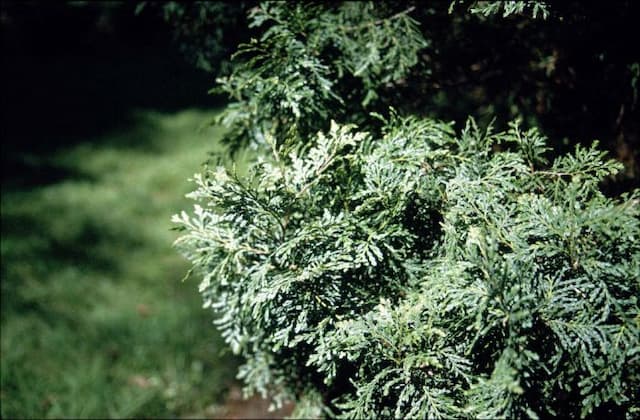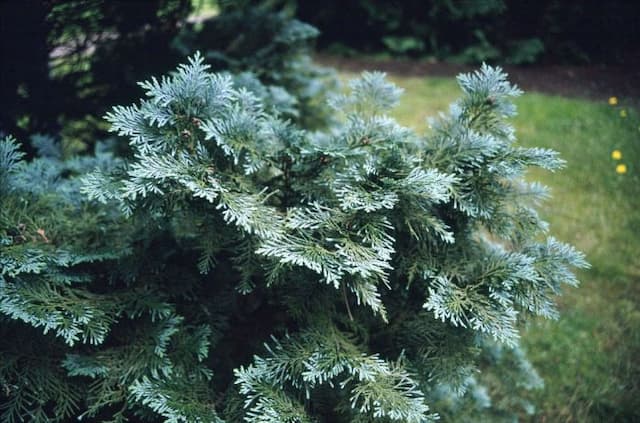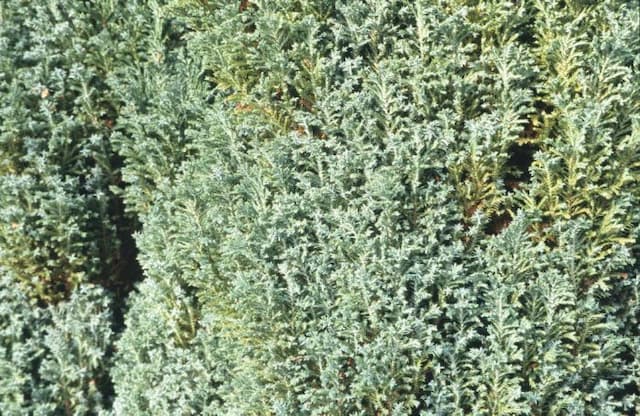American Arborvitae Thuja occidentalis Golden Smaragd = 'Janed Gold' (PBR)

ABOUT
Thuja occidentalis Golden Smaragd, commonly known as the American Arborvitae, is an ornamental evergreen conifer that is noted for its vibrant foliage color. The plant takes on a distinctive pyramid shape with dense, compact growth that forms a neat conical outline. The leaves of the American Arborvitae are arranged in flat sprays, and the foliage color is a radiant golden-yellow which tends to be most vivid at the tips of the branches, especially when exposed to full sun. In shaded conditions, the foliage may take on a more greenish hue. As the seasons change, the brightness of the golden color can fluctuate, often intensifying in the spring with the flush of new growth, then turning into a warmer, deeper golden hue as colder weather arrives. The contrast between the young, lighter-colored growth and the older foliage adds a multi-dimensional aspect to the plant's overall visual appeal. The leaves are small, scale-like, and tightly packed, creating a textured appearance that is pleasing to the eye. The American Arborvitae produces small, brown, woody cones that are typically not very prominent, growing only about a half an inch long. These cones add an additional layer of interest upon closer inspection but are not the main feature of the plant. Overall, the American Arborvitae Gold Smaragd 'Janed Gold' stands out in the landscape due to its unique color, symmetrical growth habit, and ornamental presence. Its radiant foliage makes it a popular choice for gardeners seeking to add a touch of brilliance to their garden design.
About this plant
 Names
NamesSynonyms
Eastern Arborvitae, American Arborvitae, Northern White Cedar, Yellow Cedar.
Common names
Thuja occidentalis 'Janed Gold', Thuja occidentalis Golden Smaragd
 Toxicity
ToxicityTo humans
The common name for Thuja occidentalis 'Golden Smaragd' is American arborvitae. This plant is considered mildly toxic to humans if ingested. It contains compounds called thujones, which can be harmful when consumed in large quantities. Symptoms of poisoning may include nausea, vomiting, diarrhea, and in severe cases, seizures, muscle weakness, or difficulty breathing. It is advisable to seek medical attention if ingestion occurs and symptoms are present.
To pets
American arborvitae is also known to be toxic to pets, especially cats and dogs. If ingested, the thujone present in the plant can cause symptoms such as vomiting, diarrhea, excessive drooling, and in severe cases, it may lead to seizures or liver damage. It is important to prevent pets from ingesting this plant and to consult a veterinarian immediately if any parts of the plant are consumed.
 Characteristics
CharacteristicsLife cycle
Perennials
Foliage type
Evergreen
Color of leaves
Golden
Height
15 feet (4.57 meters)
Spread
4 feet (1.22 meters)
Plant type
Shrub
Hardiness zones
3
Native area
North America
Benefits
 General Benefits
General Benefits- Easy Maintenance: Requires minimal care and pruning to maintain its shape.
- Year-Round Aesthetic Appeal: Retains its vibrant golden color throughout the seasons.
- Drought Resistance: Once established, it can tolerate periods of dry weather.
- Privacy Screen: Dense foliage provides excellent privacy and acts as a natural windbreak.
- Pest Resistance: Generally resistant to common pests and diseases.
- Compact Size: Ideal for small gardens or restricted spaces due to its moderate growth rate.
- Wildlife Habitat: Can serve as shelter and nesting site for birds and other wildlife.
- Winter Interest: Adds color and structure to the garden during the dull winter months.
- Soil Adaptability: Capable of growing in a range of soil types, assuming they are well-drained.
- Landscape Versatility: Suitable for hedges, specimen plantings, and foundation plantings.
- Hardiness: Adapted to withstand cold climates and frost conditions.
 Medical Properties
Medical Properties- This plant is not used for medical purposes.
 Air-purifying Qualities
Air-purifying QualitiesThis plant is not specifically known for air purifying qualities.
 Other Uses
Other Uses- Aromatic Filler in Potpourri: The foliage of Thuja occidentalis 'Golden Smaragd' can be dried and added to potpourri mixes for its pleasant scent and aesthetic appeal.
- Crafting Material: The branches and small twigs can be used in floral arrangements or woven into decorative wreaths and garlands for festive decorations.
- Woodworking: The wood of this thuja is soft, fine-grained, and easy to work with, making it suitable for small woodworking projects such as carving or making wooden toys.
- Erosion Control: When planted in rows or hedges, it can act as an effective windbreak and help prevent soil erosion in vulnerable landscapes.
- Habitat for Wildlife: These plants can provide shelter and nesting sites for birds and other small animals within a garden ecosystem.
- Privacy Screening: Due to its dense growth habit, Thuja occidentalis 'Golden Smaragd' can be used to create natural privacy screens between properties.
- Noise Reduction: When planted in dense rows, these trees can help absorb sound and reduce traffic or neighborhood noise levels.
- Theme Gardens: This variety of thuja can be included in gold or yellow themed gardens to provide a striking foliage contrast.
- Photography Backgrounds: The rich texture and color provide an excellent backdrop for outdoor photography sessions, especially in formal gardens.
- Culinary Smoking: While not common, the wood chips can occasionally be used for smoking meats to add a unique flavor, though it's important to use it sparingly due to potential bitterness.
Interesting Facts
 Feng Shui
Feng ShuiThe Arborvitae is not used in Feng Shui practice.
 Zodiac Sign Compitability
Zodiac Sign CompitabilityThe Arborvitae is not used in astrology practice.
 Plant Symbolism
Plant Symbolism- Longevity and Everlasting Life: Thuja occidentalis, commonly known as "Arborvitae," which means "tree of life" in Latin, symbolizes longevity and everlasting life due to its evergreen nature and its historic use by Native Americans for its purported life-sustaining properties.
- Protection: Arborvitaes are often planted in rows and used as natural fencing, which gives them an association with protection and privacy. Their dense foliage serves as a shield against winds and noise, hence providing a protective barrier.
- Resilience: These hardy plants can survive harsh conditions and are disease resistant, which makes them a symbol of resilience and the ability to endure difficult times, staying strong and vibrant.
- Health and Healing: The arborvitae has been used medicinally by several cultures, symbolizing health and healing. Its essential oils and extracts have been historically used to treat various ailments, suggesting vitality and wellness.
- Peace and Tranquility: Due to its lush green appearance and its use in landscaped gardens, arborvitaes can symbolize peace and tranquility, creating serene and calming environments where they are grown.
 Water
WaterThe American Arborvitae (common name for Thuja occidentalis Golden Smaragd) should be watered deeply and thoroughly to ensure the root zone is moistened, which typically means providing about 1 inch of water per week. During hot or dry periods, increase the frequency to twice a week, ensuring the soil does not become waterlogged. In winter, reduce watering to account for slower growth and natural precipitation. The plant needs consistent moisture, especially in the first few growing seasons to establish a deep root system. It is best to use a soaker hose or drip irrigation system to deliver water directly to the roots and avoid overhead watering, which can cause foliage diseases.
 Light
LightThe American Arborvitae thrives in full sun to partial shade. It performs best when it receives at least 6 hours of direct sunlight each day but can tolerate light afternoon shade. The ideal spot would be an area that gets bright, unfiltered sunlight for most of the day, ensuring healthy growth and the best color of foliage.
 Temperature
TemperatureThe American Arborvitae can withstand a wide range of temperatures and is hardy to USDA zone 3. It can survive minimum temperatures down to around -40 degrees Fahrenheit and maximum temperatures that typically occur in its hardiness zones. The ideal growing temperatures for the American Arborvitae range between 40 degrees Fahrenheit and 75 degrees Fahrenheit, where it can grow robustly without stress.
 Pruning
PruningPruning the American Arborvitae helps maintain its desired shape and size, as well as to remove any damaged or diseased branches. Pruning should be done in late winter or early spring before new growth starts. Light pruning can be done annually, but major shaping should be done less frequently, as Thujas do not respond well to severe pruning. Dead or broken branches should be removed as soon as they are noticed.
 Cleaning
CleaningNot needed
 Soil
SoilAmerican Arborvitae 'Golden Smaragd' thrives in well-draining soil, with a pH range of 6.0 to 8.0. A mixture of loam, peat, and some sand or perlite is ideal for proper drainage and moisture retention. Organic matter such as compost can also be added to enrich the soil and support healthier growth.
 Repotting
RepottingAmerican Arborvitae 'Golden Smaragd' is typically a landscape plant and does not require repotting as it is planted outdoors. If grown in a container, it should be repotted when it outgrows its current pot, which is usually every 2 to 3 years.
 Humidity & Misting
Humidity & MistingAmerican Arborvitae 'Golden Smaragd' is adaptable but prefers moderate humidity levels. It can withstand the natural outdoor humidity fluctuations but does not require specific supplemental humidity when planted in its appropriate hardiness zones.
 Suitable locations
Suitable locationsIndoor
It's not ideal for indoor growth; ensure ample light.
Outdoor
Plant in full sun to partial shade, water deeply.
Hardiness zone
3-7 USDA
 Life cycle
Life cycleThuja occidentalis Golden Smaragd, commonly known as the American arborvitae 'Golden Smaragd', begins its life as a seed, which germinates in moist soil conditions typically in spring. The seedling stage follows, where the plant establishes its root system and starts developing its distinctive conical shape. As it enters the juvenile stage, rapid growth occurs and the golden-green foliage becomes denser and more vibrant. Reaching maturity, the arborvitae 'Golden Smaragd' may slow in growth but continues to thicken, maintaining its shape and color, and begins to produce cones. In its reproductive stage, the cones mature, releasing seeds that perpetuate the species' life cycle. This evergreen can live for many decades, remaining relatively compact and manageable in size, and in its final stage, it gradually declines in health before eventually dying, which can occur from natural senescence or external stresses such as disease or harsh environmental conditions.
 Propogation
PropogationPropogation time
Spring to Summer
The most popular method of propagating the Eastern arborvitae 'Janed Gold' is by softwood cuttings. This process typically occurs in late spring or early summer, when new growth is soft and pliable but not yet hardened. Cuttings are usually taken from new growth, about 5 to 6 inches long, making a clean cut just below a node. The cut end is then dipped in rooting hormone to encourage root development and planted in a well-draining potting mix or directly into a propagation bed. The cutting should be kept moist and in a shaded, humid environment until roots develop, which can take several weeks. Once rooted, the plants can gradually acclimate to more sun and less humidity before planting out in their final location.









